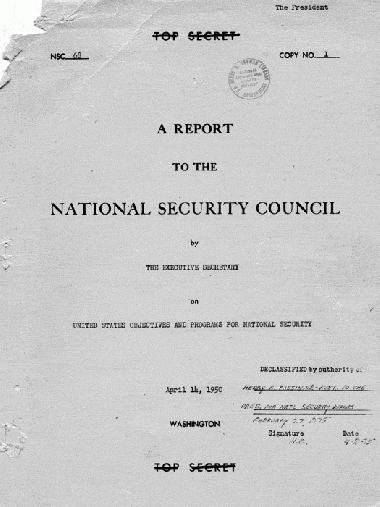Difference between revisions of "NSC-68"
(Stub) |
|||
| (4 intermediate revisions by 2 users not shown) | |||
| Line 1: | Line 1: | ||
| − | {{ | + | {{publication |
| − | | | + | |wikipedia=https://en.wikipedia.org/wiki/NSC-68 |
| − | |type= | + | |image=NSC-68.gif |
| − | | | + | |image_width=380px |
| − | | | + | |type=policy paper |
| − | | | + | |authors=US/National Security Council, US/Department/Defense, US/Department/State |
| + | |publication_date=April 14, 1950 | ||
| + | |subjects=Cold War | ||
}} | }} | ||
| + | '''United States Objectives and Programs for National Security''', better known as '''NSC 68''', was [[top secret]] U.S. National Security Council (NSC) policy paper drafted by the [[Department of State]] and [[Department of Defense]] and presented to President Harry S. Truman on 7 April 1950. It was one of the most important American policy statements of the [[Cold War]]. | ||
| + | |||
| + | In the words of scholar [[Ernest R. May]], NSC 68 "provided the blueprint for the militarization of the [[Cold War]] from [[1950]] to the collapse of the [[Soviet Union]] at the beginning of the [[1990s]]." NSC 68 and its subsequent amplifications advocated a large expansion in the military budget of the United States, the development of a [[hydrogen bomb]], and increased military aid to allies of the United States. It made the rollback of global Communist expansion a high priority and rejected the alternative policies of détente and [[containment]] of the Soviet Union.<ref>https://en.wikipedia.org/wiki/NSC-68</ref> | ||
| + | |||
{{SMWDocs}} | {{SMWDocs}} | ||
==References== | ==References== | ||
{{Reflist}} | {{Reflist}} | ||
Latest revision as of 00:21, 13 September 2024
 | |
| Type | policy paper |
| Publication date | April 14, 1950 |
| Author(s) | • US/National Security Council • US/Department/Defense • US/Department/State |
| Subjects | Cold War |
United States Objectives and Programs for National Security, better known as NSC 68, was top secret U.S. National Security Council (NSC) policy paper drafted by the Department of State and Department of Defense and presented to President Harry S. Truman on 7 April 1950. It was one of the most important American policy statements of the Cold War.
In the words of scholar Ernest R. May, NSC 68 "provided the blueprint for the militarization of the Cold War from 1950 to the collapse of the Soviet Union at the beginning of the 1990s." NSC 68 and its subsequent amplifications advocated a large expansion in the military budget of the United States, the development of a hydrogen bomb, and increased military aid to allies of the United States. It made the rollback of global Communist expansion a high priority and rejected the alternative policies of détente and containment of the Soviet Union.[1]
Related Document
| Title | Type | Publication date | Author(s) | Description |
|---|---|---|---|---|
| Document:Sins of Statecraft - The War on Terror Exposed | paper | 29 July 2006 | Brian Bogart |